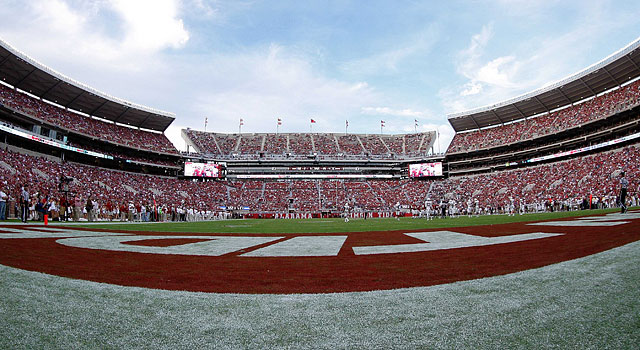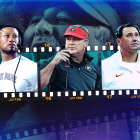
Every day, Mississippi State athletic director Scott Stricklin has conversations with employees about ways to be efficient with the athletic department's money. Mississippi State isn't exactly hurting with a budget around $60 million, but that's a gap of $40 million or more from most of its SEC West opponents.
"The best description is we have a nice, middle-class house," Stricklin said, "but we live in a neighborhood in the SEC where everybody lives in mansions."
Mississippi State's spending habits would be off the radar except for one thing: The Bulldogs are the No. 1 football team in America. Entering Saturday's SEC West showdown at financial juggernaut Alabama, Mississippi State is proof of the power of efficiency in college football, even if Stricklin is reluctant to say precisely where saving dollars makes sense.
"I'd hate to say," Stricklin said. "I hope some people will keep spending money in some of those areas. We have more resources than we've ever had and because there's so much more money in the system, I'm not sure the advantage of having more money means as much as it once did."
"Moneyball" has come to college football, where there are only so many ways to spend lavishly on facilities and salaries. Half of the top eight teams in this week's College Football Playoff rankings live in the middle class financially -- No. 1 Mississippi State, No. 4 TCU, No. 6 Arizona State and No. 7 Baylor.
| Athletic Finances From Playoff Contenders (2012-13 data) | |||
| School | Revenue | Expenses | Revenue from subsidy |
| No. 1 Mississippi State | $62.8 million | $57.4 million | 4.8% |
| No. 2 Oregon | $115.2 million | $95 million | 2% |
| No. 3 Florida State | $91.4 million | $84.8 million | 8.6% |
| No. 4 TCU | $71.9 million | $71.9 million | N/A |
| No. 5 Alabama | $143.8 million | $116.6 million | 4% |
| No. 6 Arizona State | $65.7 million | $65.6 million | 15.4% |
| No. 7 Baylor | $78.4 million | $78.4 million | N/A |
| No. 8 Ohio State | $139.6 million | $116 million | 0% |
| Note: This chart uses 2012-13 figures because many schools have yet to file their 2013-14 data. Figures for TCU and Baylor come from their EADA reports and provide a good estimate, but not a direct comparison, in relation to data from the other six schools. Sources: USA Today Sports and U.S. Department of Education’s Equity in Athletics Data Analysis. | |||
Those schools' estimated rankings based on 2012-13 athletic department revenue: No. 36 Baylor, No. 43 TCU, No. 51 Arizona State and No. 56 Mississippi State. (The rankings are estimates because the private school and public school figures come from different sources. A school's annual NCAA report uses audited numbers and includes debt service, unlike the annual report sent to the US Department of Education that is the only source of information for private schools.)
Mississippi State, TCU, Arizona State and Baylor compete in conferences with far-wealthier athletic departments that exceed $100 million in revenue. Don't get them wrong: Baylor, TCU, Mississippi State and Arizona State want more money and they're increasing their revenue.
"But our margin for error doesn't exist whereas some of the high-resourced schools can overcome things that don't work out a lot better than we can," Baylor athletic director Ian McCaw said. "We have to be good stewards of our resources and get things right."
Baylor listed $86.9 million in 2013-14 athletic department revenue on its most recent Equity in Athletics Data Analysis (EADA) survey. TCU listed $77.1 million on the same survey. Arizona State reported $74.7 million for its 2013-14 EADA numbers. Mississippi State listed $62.2 million on its NCAA report.
Think of it this way: Mississippi State's dollars are closer to the University of Alabama at Birmingham than the University of Alabama in Tuscaloosa. The Crimson Tide generated $152.6 million in athletic revenue last year and spent $115.4 million, according to its most recent EADA survey.
"We can't be defined by the size of our budget," Stricklin said. "If everything is about money, we run out before everybody else. We have to make it about how we identify talent, how we develop talent and how we attract and retain coaches."
Fighting money or fighting brands?
TCU athletic director Chris Del Conte doesn't buy the notion his program is fighting money. He views it that the Horned Frogs are fighting brands.
"I don't think it's about money because you have a cap on the kids you can get," Del Conte said. "It's not like free agency. Players win games. You can say Texas has this budget or Oklahoma has this budget, but they can only sign 25 kids. Resources play a huge component, but parity in scholarship numbers has been a major factor."
| Recruiting rankings | |
| School | Avg Rank |
| No. 1 Mississippi State | No. 29 |
| No. 2 Oregon | No. 16 |
| No. 3 Florida State | No. 5 |
| No. 4 TCU | No. 34 |
| No. 5 Alabama | No. 1 |
| No. 6 Arizona State | No. 41 |
| No. 7 Baylor | No. 31 |
| No. 8 Ohio State | No. 4 |
| Note: The average national recruiting rankings from 2011 to 2014 according to 247Sports.com for the top eight teams in the current College Football Playoff rankings. | |
Mississippi State, Baylor, Arizona State and TCU barely sniff the top 25 in recruiting rankings, much less consistently crack the top-10 like schools with more money. But as more players leave early for the NFL, there's greater value in teams having experienced and reliable players at a time when wealthier schools are younger.
Meanwhile, coaches such as Gary Patterson search for diamonds in the rough that fit his system. Standout TCU quarterback Trevone Boykin's only scholarship offers were TCU and UTEP.
"Think about that. That's an eye for talent," Del Conte said. "There are 500 kids a year from Texas who play college football. Texas A&M, Oklahoma and Texas can only get 75."
Four years have passed since then-Ohio State president Gordon Gee made his infamous "Little Sisters of the Poor" comment about TCU's schedule while in the Mountain West Conference. Gee's point at the time: TCU and Boise State did not deserve to play for the BCS championship even if they went undefeated.
Then TCU beat Wisconsin at the Rose Bowl and conference realignment happened. When Texas A&M headed to the SEC, the door opened for TCU to enter its fifth conference in 16 years by joining the Big 12 and returning to its Southwest Conference roots. Baylor helped hold the Big 12 together by threatening legal action, and Utah and TCU became the only non-BCS schools to jump into the current Power 5 conferences.
"We had a 16-year odyssey, but that was the greatest thing that happened to us," Del Conte said. "We had to look back at ourselves and say, why them and not us? We reinvested in ourselves, we didn't blame. Whether we got in the Big 12 or not, we were already building a stadium. Whether we got in the Big 12 or not, we were already winning the Rose Bowl."
At perpetually underachieving Arizona State, coach Todd Graham puts national championship stickers on practice helmets and displays a large sign with the national championship trophy. Graham doesn't shy away from high expectations.
"His whole vision is if he makes people think about the ultimate goal, he gets there sooner," said Rocky Harris, chief of staff for Arizona State's athletic department. "That's really new for me as someone who has worked in pro sports and college sports. You don't try to contain him because that's what makes him special in our eyes."
Arizona State's budget has increased from $53 million to $74.9 million within five years. Investments have been made. Arizona State is planning a $256 million renovation to its football stadium and the surrounding area.
"It's nice that Alabama has whirlpools and all those great amenities, but we also have a lot to offer that the public is starting to see," Harris said. "If we're ever trying to keep up with Ohio State and Texas, we won't get there. We need to create our own path."
| SEC Revenue (2012-13) | |
| School | Athletic Revenue |
| Alabama | $143.8 million |
| Florida | $130 million |
| LSU | $117.5 million |
| Tennessee | $111.6 million |
| Auburn | $103.7 million |
| Arkansas | $99.8 million |
| Georgia | $98.1 million |
| Kentucky | $95.7 million |
| Texas A&M | $94 million |
| South Carolina | $90.5 million |
| Missouri | $76.3 million |
| Ole Miss | $73.4 million |
| Mississippi State | $62.8 million |
| Vanderbilt | $61.1 million |
| Sources: USA Today Sports (13 of the 14 schools) and U.S. Department of Education’s Equity in Athletics Data Analysis (Vanderbilt). | |
Arizona State's path includes one of the highest rates of public subsidies among major athletic departments. According to USA Today Sports' financial database of athletic departments, Arizona State athletics received $41.5 million from the university between 2010 and 2013.
In 2012-13, 15.4 percent of Arizona State's athletics revenue was subsidized by the university. Among the 43 public universities ranked ahead of Arizona State in revenue that year, only Rutgers (59.5 percent) and Virginia (15.5 percent) had higher subsidy rates. Arizona State's reliance on university funds decreased in recent years since peaking at 31 percent in 2007.
Now a new revenue source of subsidies has emerged. Starting this year, about 76,000 students at Arizona State are paying $75 a semester in student fees to help fund athletics. The other two state universities, Arizona and Northern Arizona, don't charge a student athletic fee.
"We made the student a stakeholder in our business now," Harris said. "They have a say where the money goes."
TV edge for major programs is gone
During the final 11 years of the Bowl Championship Series, the same 11 schools played for the national championship out of 22 available spots. They're household names -- Florida State, Auburn, Alabama, Notre Dame, LSU, Oregon, Texas, Florida, Oklahoma, Ohio State and USC -- and it's quite possible two of them meet for the title to start the College Football Playoff era.
By 2012-13, all of those athletic departments had exceeded $90 million in annual revenue, although they weren't all traditional brands. When Oregon played Auburn in the 2011 BCS Championship Game, Oregon's most recent financial info at the time showed the Ducks trailed Auburn in revenue by $28 million.
"You may think Oregon is a traditional power. I don't think they are," Del Conte said. "They've been a power since 1994. We've been on top of the mountain (at TCU) since 1998. Why? Because of parity and opportunity."
It's debatable if the Horned Frogs have been "on top" given that they had a combined 11-14 record during their first two seasons in the Big 12. But Del Conte's point is fair: TCU earned its way into the national conversation due to nine 10-win seasons from 2000 to 2011, including some highly publicized wins.
Television has helped change the dynamic for lower-resourced teams. A decade ago, Baylor would appear on TV at most three times in a season. Now every Big 12 game is televised.
Baylor invested in coach Art Briles, recently opened a $266 million stadium, and rode the wave of good feelings after Robert Griffin III's Heisman Trophy season of 2011. As private schools with smaller alumni bases, TCU and Baylor will always have less volume to draw upon. But Baylor now has 28,000 season-ticket holders compared to 8,000 in 2003. The athletic department budget has grown by 315 percent in the past decade, placing Baylor in the middle of the Big 12 financially, McCaw said.
"The television gap has disappeared," McCaw said. "In terms of resources, when we were 12th out of 12 in the Big 12, we were so far behind it felt like 18th out of 12 at that point. We didn't really have the resources to be in position to be successful."
The SEC is in its sixth year of a lucrative contract with ESPN that assures every game is on TV. Before the 2009 deal with ESPN, Mississippi State was televised four or five times a year.
"That television exposure is significant and has been lost in a lot of the conversation about money," Stricklin said. "The exposure deficit has completely gone away. From a marketing perspective to expose your brand to fans and student-athletes, it's huge that every game we play is on TV."
| Alabama vs. Mississippi State in Dollars (2012-13) | ||
| Category | Alabama | Miss. State |
| FB Ticket Sales | $36.2 million | $9.1 million |
| Athletic Dept. Contributions | $34.2 million | $6.9 million |
| Brodacst/TV/Radio/Internet Rights | $10.9 million | $4.1 million |
| Royalties/Licensing/Advertising/Sponsorships | $11.2 million | $841,852 |
| Football Camp Revenue | $584,616 | $188,000 |
| Football Total Operating Revenue | $88.7 million | $25.8 million |
| FB Coaches Total Compensation | $12 million | $5.4 million |
| Football Support Staff Compensation | $2.9 million | $890,580 |
| Football Recruiting Expenses | $983,721 | $468,536 |
| Football Equipment/Uniforms/Supplies | $1.6 million | $634,221 |
| Football Camp Expenses | $647,774 | $156,871 |
| Football Medical Expenses/Insurance | $1.2 million | $228,328 |
| Football Total Operating Expenses | $41.6 million | $15.3 million |
| Sources: Alabama and Mississippi State 2012-13 NCAA financial reports | ||
In Dan Mullen, Stricklin has a football coach who embraced Mississippi State's model of efficiency. Mullen's total compensation of $3 million in 2014 is among the lowest for SEC coaches — both a sign of Mississippi State's residence in its SEC neighborhood and how high salaries have gone up.
In 2012-13, Alabama spent nearly as much money as on its football coaches and support staff ($14.9 million) as Mississippi State spent on its total football operating costs ($15.3 million). Stricklin said he believes there's a diminishing return at some point on the value of hiring so many quality-control coaches and graduate assistants. "We have enough revenue and resources to build a team that can be successful," he said. "I do think that when you're a non-traditional power, your margin for error year to may be a little bit smaller than somebody like Alabama. Alabama kind of sets the standard, and it's a credit to them."
Alabama has more highly recruited players than Mississippi State. Alabama leads Mississippi State 77-18-3 all-time on the field. Alabama tops Mississippi State in revenue by about $90 million.
Despite those advantages, they'll still play their highly-anticipated football game Saturday in Tuscaloosa. All that's at stake is control of the most competitive division in the country and a playoff berth.
"When we go into Bryant-Denny Stadium and look up on the scoreboard, there's no dollar signs up there," Stricklin said. "Now, there's evidence of dollar signs all around you, but there's no dollar signs on the scoreboard at 2:30 p.m., based on how we're judged."




















